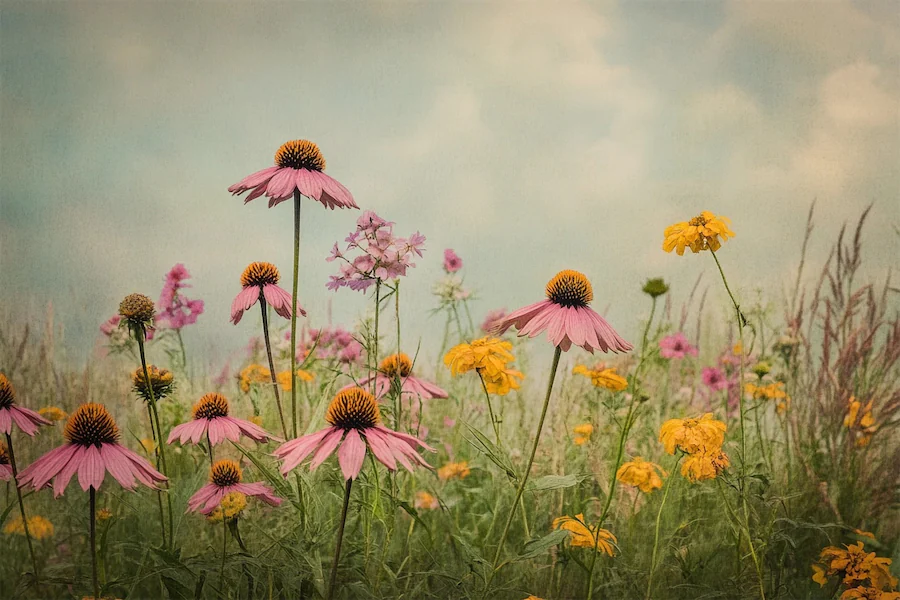A prairie garden emulates the natural beauty of North American prairies, featuring a harmonious blend of native grasses and wildflowers. This design approach fosters biodiversity, supports pollinators, and offers a low-maintenance, sustainable landscape.
History and Origins of Prairie Gardens
Prairie gardens draw inspiration from the vast grasslands that once covered significant portions of North America. Landscape architects like Jens Jensen in the early 20th century championed the incorporation of native prairie elements into garden design, emphasizing the importance of regional plant communities and naturalistic aesthetics.
Key Features of Prairie Gardens
Prairie gardens are characterized by several distinctive features:
- Diverse Plant Selection: A mix of native grasses and flowering perennials provides year-round interest and supports local wildlife. Incorporating at least 33% to 50% grasses helps suppress weeds and supports the prairie flowers, eliminating the need for staking.
- Seasonal Interest: Selecting plants with staggered bloom times ensures continuous color and texture throughout the seasons. For example, pairing early-blooming blue star (Amsonia) with mid-season black-eyed Susan (Rudbeckia hirta) and late-blooming aromatic aster (Symphyotrichum oblongifolium) provides a dynamic display.
- Naturalistic Layout: Informal groupings and drifts of plants mimic natural prairie ecosystems, creating a relaxed and flowing appearance. Designing curving pathways and layered plantings enhances the sense of immersion in a natural landscape.
- Low Maintenance: Once established, prairie gardens require minimal watering and fertilization, as native plants are adapted to local conditions. Incorporating grasses helps reduce the need for staking and minimizes weed intrusion.
Applications of Prairie Gardens
Prairie gardens can be adapted to various settings:
- Residential Landscapes: Homeowners can transform traditional lawns into vibrant prairie gardens, enhancing curb appeal and providing habitat for pollinators. Utilizing native plants reduces maintenance and supports local ecosystems.
- Public Spaces: Parks and community areas can incorporate prairie plantings to educate the public about native ecosystems and promote biodiversity. Such spaces offer aesthetic beauty and serve as refuges for wildlife.
- Corporate Campuses: Businesses can create sustainable and attractive landscapes by integrating prairie gardens, demonstrating environmental stewardship and reducing landscaping costs. These gardens can also provide pleasant outdoor spaces for employees and visitors.
Considerations When Designing a Prairie Garden
When planning a prairie garden, consider the following:
- Site Assessment: Choose a location that receives full sun for most of the day, as most prairie plants thrive in sunny conditions. Ensure the soil is well-drained to prevent root rot.
- Plant Selection: Opt for native species suited to your region to ensure adaptability and ecological benefits. Consult local extension services or native plant societies for recommendations.
- Maintenance: While prairie gardens are low-maintenance, they require some care to remain healthy. Water deeply but infrequently during the first growing season to encourage deep root growth. After establishment, supplemental watering is usually only necessary during prolonged dry spells.
- Design Principles: Incorporate at least 33% to 50% grasses in the garden design. The grasses help to squeeze out weeds, lend support to the prairie flowers, and provide late-season interest with their fall colors.
Conclusion
Prairie gardens offer a sustainable and visually appealing alternative to traditional landscapes, fostering biodiversity and connecting us to the natural heritage of the prairies. By thoughtfully selecting native plants and embracing naturalistic design principles, you can create a dynamic and resilient garden that thrives with minimal intervention.
